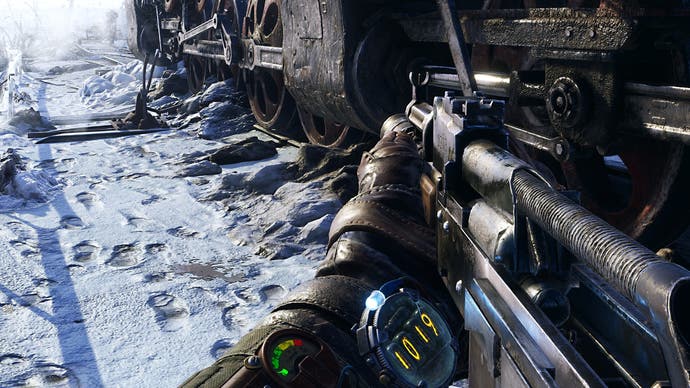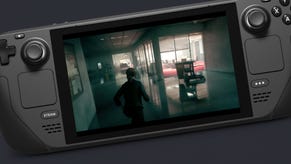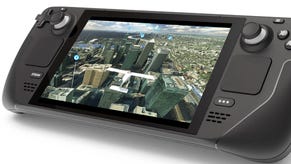Metro Exodus is a 4A game for the 4K era
Hands-on with Xbox One X.
One of the most memorable reveals of the last year's Microsoft E3 media briefing, 4A Games' Metro Exodus seemed to offer a formula that looked too good to be true - a successful transition of an established linear shooter into a similarly well-crafted open world epic. One year on, having spent a few hours hands-on with the game, there's the sense that the promise suggested by that stunning demo has been fulfilled. Exodus is indeed Metro as we know it, but built within a more open-ended environment, with all the opportunities that offers.
Strictly speaking though, while the new 4A game looks and plays like an open world shooter, it's more accurate to say that it's actually more of a collection of smaller sandbox areas, though the developer says that taking the straight, linear path through just one offers around five hours of play. Concentrating the focus opens the door to more variety from one area to the next, simultaneously retaining the sense of a hand-crafted - as opposed to a semi-procedurally generated - environment. There's also the sense that aside from some clearly signposted objectives, the player is very much left to his own devices; side-quests abound, but your map won't get populated with masses of non-descript icons. Extracurricular activities aren't a box-ticking exercise here, but rather something that you organically discover during play.
Metro series purists can certainly rest easy. Despite Metro's emergence into a bigger world, the game feels instantly familiar. It begins with your kit: the guns, Geiger counters and gas masks return, and the weaponry - including the infamous bastard gun - again feels familiar. But everything comes with a twist, such as the new weapons customisation feature. It's a down to earth and straightforward system: if you find a new gun, you've got the option to collect it. Alternatively, you can strip it for parts and use them to customise your existing arsenal. Series protagonist Artyom is gifted a backpack that not only houses his kit but also doubles up as a makeshift crafting shop, where you can strip and reassemble weapons or conjure up new supplies.
It's a Metro game, so the marshalling of resources and effectively getting the most 'bang for the buck' out of meagre provisions and a constant lack of ammunition is the key to making progress. And with that in mind, it goes without saying that by extension, this game poses a stiff challenge, with the nature of the open world itself offering a multitude of options in how you choose to progress. In the level opened up to press, simply travelling across the level requires thought and planning. Do you take stay on land and risk attack from mutants and bandits, or do you take a boat out onto the water, where vast mutated creatures may attack? And then there's the fact that Metro Exodus has a time of day system - so travelling by night reduces your chances of being attacked by humans, but perhaps some nastier nocturnal creatures will cause you problems instead.
The more open design also offers up a lot more freedom in how you tackle encounters. The stealth system from prior Metro titles is expanded upon in this sequel (helped immensely with the in situ weapons customisation system) and the simple fact that you're often out in the open offers multiple directions in tackling your opponents. In the level made available to press, there's also a good degree of verticality in the map, a dimension that hasn't really been explored in depth before in the series - and in addition to long-range sniping, it's also great for appreciating how well the new 4A engine handles extreme view distances.
And as you might expect from a developer of this pedigree, the technology powering the game is unique and remarkable - the first game from 4A designed with the capabilities of the current-gen machines in mind with no legacy platforms to hold it back. The b-roll assets used for the video on this page come directly from the PC version operating at 4K resolution, 60 frames per second. I played on Xbox One X though, finding that the visuals are remarkably similar, with the same native ultra HD resolution. The difference is frame-rate, where the current, unoptimised build has a 30fps frame-rate cap with adaptive sync, introducing tearing when performance can't meet its target.
4K is a an exceptional fit for the 4A engine, with its emphasis on extreme, high frequency detail - and as usual for this developer, there's still a heavy reliance on real-time lighting and shadowing, post-process effects and well-integrated physics. Lighting has always been key to the Metro aesthetic, but the move to the outdoors sees a shift to more natural lighting, with more subtle indirect shading visible mostly in indoor scenes. And although it's not active in the current b-roll assets, PC users with next-gen Nvidia hardware benefit from a ray-traced global illumination pass that takes this element of the game to the next level. At the press event, staff confirmed that the recent RTX ray-tracing demo shown at GDC this year was running on just the one Titan V card, potentially opening the door to consumer level accessibility for this feature when the new Nvidia hardware arrives.
We also learned that 4A has moved to a full physically-based rendering pipeline, a great match for the various metals, leather and cloth seen in the game. Due to the post-apocalyptic setting, materials aren't uniform: they have wear, scratches, grim, bumps and tears etched into their surfaces - a perfect fit for this technique. In terms of other lighting features, screen-space reflections from the PC versions of Metro Redux return in Exodus, utilised on surfaces like the metal of your gun, on wet ground in outdoor scenes and extending to large bodies of water too, a dominant feature of the landscape in the level I played. And again, just like the Redux games, 4A has made generous use of height map-based displacement for surface detail, either in the form of tessellation or parallax occlusion mapping. It provides an extra layer of detail in an already sumptuous game.
Character modelling - a weakness of the earlier Metro games - also gets a substantial upgrade in Exodus. When it comes to mutated humans or rampaging beasts, 4A has always been second to none, but character rendering could've been better. Human model rendering - particularly faces - shows a big improvement, but facial animation isn't quite up to the triple-A standard, and it doesn't look like facial performance capture is in place here, leading to dialogue that plays out looking oddly detached from the character.
Based on a couple of hours of play, I left the Metro Exodus event excited by what I'd seen. The game is set for release in February 2019, and this gives 4A time to polish the experience, optimise for performance and iron out the remaining bugs. The publisher isn't talking about performance specifically, but the 30fps target seen here is fine for a game with this extreme level of detail but with that said, the superb 60fps of the console Redux games is missed, so it would be great to get a performance mode for the enhanced consoles.
4A knows its tech, clearly, and the real issue here is how well the Metro formula integrates with a much larger world. By and large, the transition is seamless, but it's worth stressing that this still is very much a Metro game. This isn't your usual triple-A fare and it's brutally unforgiving if you try to play it like a standard FPS, with 4A exploring the open world concept very much on its own terms. It's a visually arresting, unique experience though and from a Digital Foundry perspective, we're really looking forward to learning more about its technology, the scalability across platforms and just what kind of surprises and bonuses 4A has in store for PC users.











